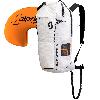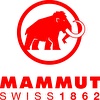Eiger Direttissima free, Jasper and Schaeli interview after the John Harlin route

 1 / 4
1 / 4 Frank Kretschmann
Frank Kretschmann
After having teamed up together in September 2009 to carry out the first free ascent of the Japanese Diretissima on the North Face of Eiger, Robert Jasper and Roger Schaeli recently joined forces once again to free another existing line on the same mountain, the legendary John Harlin Direttissima. The two spent three days climbing the 1800m high rock and ice ropute and encountered difficulties up to M8, 7a and E5, before exiting up the classic Heckmair route. Jasper first attempted the route 20 years ago and had been thwarted on three further attempts, and this autumn ascent is clear demonstration that careful timing, and above all patience, pay dividends. Seeing that he rates this as one of his personal highlights in his climbing career, more information was needed.
Robert, after the Yeti in 2006 and the Japanese route in 2009, this September it's the John Harlin Direttissima...
Yes, my main aim was to free another route close to the Japanese route I had freed with Robert in 2009. The John Harlin route is the best and most logical line up the North Face of the Eiger, a superb route with a massive history!
You spent three days up there.
If you want to free this route you have to climb very tactically, the wall is extremely dangerous. We had reckoned with 3-4 days and we took one haulbag with circa 13kg of gear, two lightweight sleeping bags, a small tent, a stove, food for 3 days and obviously all the necessary rock and ice climbing gear.
The route is reputed to have plenty of original, in-situ gear.
At times the rock on the Eiger is so compact that you can only protect the belays using bolts. We came across numerous old bolts placed during the first ascent, and on three belays these had been damaged by stone fall and so we replaced them with a new M8 bolt placed by hand. We also came across some old Petzl M8 bolt sleeves which we believe were placed during later ascents, presumably by Japanese or Czech climbers between 1980 -90 climbing in expedition style. To use these bolts you must have M8 hangers, this is really important for future repeats. The pro on the individual pitches tends to be very poor and dangerous, you need to climb with a good safety margin. We used camming devices, nuts and pegs and removed all of these.
Tell us about the biggest difficulties.
From a pure climbing point of view the main difficulties were on the first step, four pitches in the 6c- 7a mark, followed by mixed terrain. Under the Spider, on the pillar this is circa M8- and 7a. The switch from rock to mixed terrain is often very difficult and at times you climb a pitch of rock which then transforms into mixed. This means swapping climbing shoes for crampons and often its difficult to know what's best. For me this route is the most complex alpine line on the Eiger, you need a lot of experience as it takes you through the most dangerous section of the entire North Face of the Eiger.
You opted to exit via the Heckmair route
Our main aim was to free a line. The upper headwall on the Harlin Direttissima had no ice and was still covered in powder snow, and so we weren't sure it would go free. Another factor was the weather forecast, good for only one more day which we'd need for the descent. That's why we chose the exit variation via the Heckmair route.
You specified redpoint in the overall grade. How come?
For me personally the Harlin Direttissima was almost a never-ending story. redpoint, because I had attempted the route 4 times previously. The first attempt was carried out with a friend circa 20 years ago, then when I was 23 years old I attempted to solo it. Circa six years ago I dreamt of the first free ascent and we had to turn back twice, it was too cold, or there was too much powder snow, no ice where there had been plenty in 1966, no pegs, things get impossible pretty quickly...
A dream and nightmare
It was a long dream and I'm really happy to have completed this project now. It's one of my highlights in my climbing career! Add to this the fact that from an emotional point of view it was one of the toughest experiences. I had previously climbed the Heckmair route with John Harlin's son and my wife Daniela for the film "The Alps" and this family tragedy affected both of us greatly. As I happened to lead the pitch to the Spider, where Harlin fell to his death, I couldn't help thinking about my own son, about the risks on the mountain face, whether all of this is worth it or not... This was really tough.
Yet the Eiger seems to exert an irresistible attraction
Yes, the North Face of the Eiger is a truly special face, a place shrouded in history. I'm fascinated by this wall, by its powerfulness. She's very dangerous, immense and I love this enormous challenge and I continue to discover new personal goals. I don't need to travel to the "end of the world" on expeditions, there are plenty of challenges left here in the Alps.
Such as
Such as the North Face of the Eiger. But also other, more far-flung corners have plenty in store, such as the Fiescher Gabelhorn Nordwand which I first ascended a couple of years ago. it's hard to believe that something like this still exits. My message, in particular to young climbers who can't yet go on expeditions, is that it's really worth climbing in the Alps. There are plenty of prizes out there, you don't necessarily have to go on an expedition abroad. Adventure is out there, on your doorstep. You just need to look know how to look for it.
HISTORY OF THE EIGER DIRETTISSIMA
by Lindsay Griffin
"The original ascent, one of the most famous in the Alps, was a tour-de-force siege of the 1,800m face over one month during late winter 1966.
Dougal Haston joined Americans John Harlin and Layton Kor to spend a considerable amount of the winter at the foot of the face, waiting for the right conditions and weather. However, around mid February they were surprised by a large and talented German team, comprising Karl Golikow, Peter Haag, Sigi Hupfauer, Jorg Lehne, Rolf Rosenkopf, Gunther Schnaidt, Gunther Strobel and Roland Votteler, starting up the wall ahead of them.
The two teams pursued parallel lines at first, creating huge media attention, but later joined forces.
On the first summit attempt Hupfauer, Lehne, Strobel and Votteler had reached the Fly, and Harlin and Haston were jumaring up from the Death Bivouac to join them, when a free-hanging 7mm fixed line, just below the Spider, broke with Harlin attached. He fell the full length of the wall.
The remaining five climbers battled through horrendous weather for another three days to emerge on the summit, finishing the route as a tribute to the great American alpinist and naming it after him. Difficulties were rated at A3 and V+, with 80° ice and mixed, and the climb is now given an overall grade of ED3/4."
Lindsay Griffin
Highly reputable British journalist and mountaineer, compiler and editor of Mountain INFO, one of the world's most authoritative climbing resources.
| Links Planetmountain | |
| Eiger North Face, Japanese Diretissima freed by Jasper and Schäli | |
| News Eiger | |
| News Robert Jasper | |
| News Roger Schäli | |
| Links www | |
| www.thebmc.co.uk | |
| www.funst.de | |
| www.robert-jasper.de | |



 Copia link
Copia link
























